
Back Glarima AN دموع Arabic ܕܡܥܬܐ ARC МагӀу AV Göz yaşları Azerbaijani Zachal BAR Luha BCL Сляза Byelorussian Сьляза BE-X-OLD Сълза Bulgarian
This article has multiple issues. Please help improve it or discuss these issues on the talk page. (Learn how and when to remove these messages)
|

Tears are a clear liquid secreted by the lacrimal glands (tear gland) found in the eyes of all land mammals.[1] Tears are made up of water, electrolytes, proteins, lipids, and mucins that form layers on the surface of eyes.[2] The different types of tears—basal, reflex, and emotional—vary significantly in composition.[2]

- a) Lacrimal gland
- b) Superior lacrimal punctum
- c) Superior lacrimal canal
- d) Lacrimal sac
- e) Inferior lacrimal punctum
- f) Inferior lacrimal canal
- g) Nasolacrimal canal
The functions of tears include lubricating the eyes (basal tears), removing irritants (reflex tears), and also aiding the immune system.[3] Tears also occur as a part of the body's natural pain response.[4] Emotional secretion of tears may serve a biological function by excreting stress-inducing hormones built up through times of emotional distress.[5][6] Tears have symbolic significance among humans.[4]
- ^ "Definition of TEAR". www.merriam-webster.com. Retrieved 2019-08-04.
- ^ a b Cite error: The named reference
ReferenceAwas invoked but never defined (see the help page). - ^ Farandos, NM; Yetisen, AK; Monteiro, MJ; Lowe, CR; Yun, SH (2014). "Contact Lens Sensors in Ocular Diagnostics". Advanced Healthcare Materials. 4 (6): 792–810. doi:10.1002/adhm.201400504. PMID 25400274. S2CID 35508652.
- ^ a b "Why do we cry? The scientific reasons behind sobbing". The Independent. 2014-09-18. Archived from the original on 2022-05-26. Retrieved 2019-08-04.
- ^ "All About Emotional Tears". American Academy of Ophthalmology. 2017-02-28. Retrieved 2019-08-04.
- ^ Frey, W. H.; DeSota-Johnson, D.; Hoffman, C.; McCall, J. T. (October 1981). "Effect of stimulus on the chemical composition of human tears". American Journal of Ophthalmology. 92 (4): 559–567. doi:10.1016/0002-9394(81)90651-6. ISSN 0002-9394. PMID 7294117.